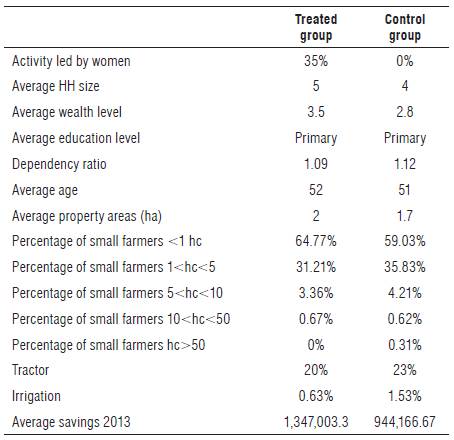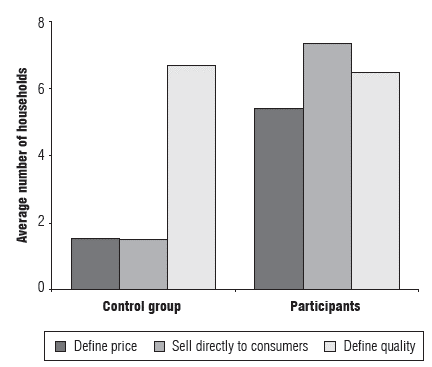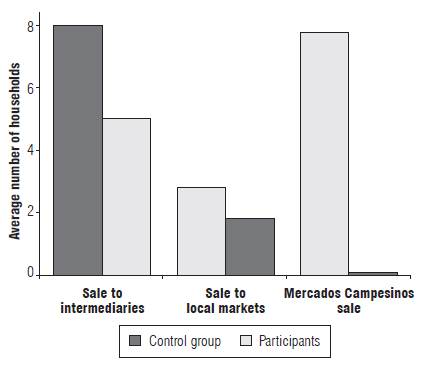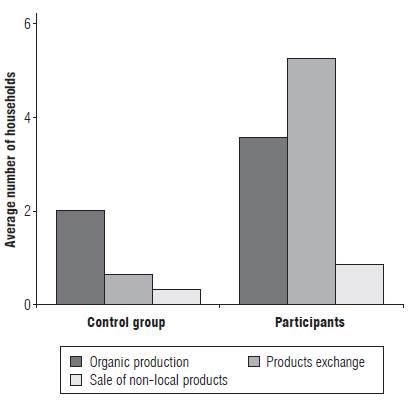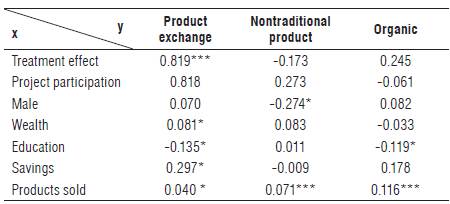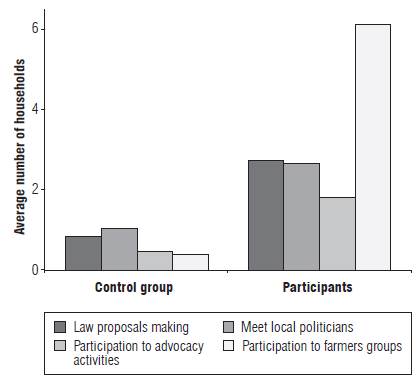Introduction
Considering its agro-ecological potential, Colombia is one of the strongest agricultural countries of Latin America (Velez et al., 2010). The agricultural sector could potentially be one of the main driving forces of social and economic development of the country. However, the sector suffers great structural problems that affect agricultural productivity causing gradual marginalization and stagnation (Cano et al., 2016). The main reasons for the sector's backwardness have been the high poverty levels, several adversities, functional instability and social violence events that Colombian smallholders have experienced for several decades (Osorio and Riva, 2017). However, despite their shortage of means, smallholders play a key role in the Colombian agricultural sector constituting 70.9% of total farms (DANE, 2016). This is why peasants can still be considered the main agricultural product suppliers, even if their market access and products commercialization are extremely compromised and strongly dependent on intermediaries (Parrado and Molina, 2014). In recent years, a new solution is arising to improve farmers market access, promote smallholders agriculture and create conditions for a sustainable rural development (Prado, 2014). In that framework, there is a growing interest for short food value chains (ECLAC-FAO-IICA, 2014) as a valuable possibility to create a profitable situation for both smallholders and consumers. Farmers' markets are a great opportunity to foster small scale agriculture and family farming and, at the same time, satisfy consumer expectations of high quality, fresh and safe food, and chemical free products (Diaz, 2014). Short food value chains create conditions for an equitable and sustainable development, reducing the gap between rural and urban areas and increasing market access opportunities for family farming. Through them, smallholders are able to diversify commercial channels, increase their product value and obtain higher and more stable income by reducing intermediaries' role (CEPAL, 2014).
Along with short food supply chain, smallholders' organizations are one of the elements that contribute to boost the productivity and competitiveness of the agricultural sector. Indeed, several researches have shown how systematization of farmers' organization has stimulated the small farmers' integration in the local and regional food supply system (Romero et al., 2017). Smallholders' organizations have improved cooperation among farmers to face economic challenges but also stand social and political injustices (Machado, 2003). Short food value chains combined with the support and systematization of farmers' associations have led to important achievements in increasing smallholders' wellbeing, improving not only living conditions of rural families but also fostering rural communities (Escobar et al., 2010).
In a context of social and political transformation of Colombian smallholders' reality, a short food supply chain experience developed in Bogota is outstanding. "Mercados Campesinos" project implemented efficient solutions to overcome bottlenecks and constraints that were affecting the smallholders of the Central region of Colombia and improved the food supply of the capital city. The project started in 2004 and ended in 2015; during this period it passed through various phases and achieved different objectives. In particular, it launched a new market channel in Bogota that allowed direct contact between producers and consumers. Thanks to the project, every two weeks farmer markets were organized in 16 squares of Bogota and smallholders coming from the rural areas surrounding the Capital could directly sell their products to customers (Gutiérrez et al., 2012). Additionally, smallholders could participate in several workshops and training workshops to better comprehend market dynamics and commercialization, improve product quality and introduce new production methods.
The project was able to combine productive transformation and institutional change using a theoretical framework based on the rural territorial development approach (Schejtman and Berdegué, 2003). With this focus, the "Mercados Campesinos" project introduced changes in the smallholders' access to Bogota food supply chain and consequently encouraged cooperation processes between local actors, among themselves and external actors with the purpose of modifying the food policy patterns of the capital (Parrado and Molina, 2014).
With its participatory approach, "Mercados Campesinos" aimed at positively influence the social, economical and political dimensions of beneficiaries providing means to achieve not only economic improvements but also social and political ameliorations (Gutierrez et al., 2012). To reach these goals, two main sub-objectives were set: i) to ensure fairer smallholders' participation in production, commercialization and product transformation and ii) to highlight the key role played by family famers in food supply and increase their political recognition, representativeness and influence in public policy definition (Ordoñez and Montoya, 2011). To achieve the latter dimension and ensure participants' engagement in all project phases, a complex organizational structure was set. All project participants were engaged in a local smallholder farmer group in which there was at least one local representative of project leading organizations (Parrado and Molina, 2014). Participation in farmers' organizations stressed the importance of collective work to obtain political recognition, facilitated organizations of farmers markets and strengthened local rural communities (Romero et al., 2017).
"Mercados Campesinos" has been an extremely complex short food supply chain experience that introduced important changes to the wellbeing of smallholders of the Central region of Colombia and redefined food supply of the capital. The research objective was to identify the overall project impact on smallholders' living conditions.
To accomplish this objective, a series of quantitative and qualitative investigation have been undertaken. An in depth and comprehensive statistical analysis has been implemented to measure the achievements of the project objectives in the three different dimensions that "Mercados Campesinos" initiative wants to improve.
Following main pillars of rural territorial development, this study was designed to identify project effects on three important dimensions: i) improvement in commercialization, ii) increase of economic efficiency, and iii) increase the farmers' political and social involvement. Additionally, the quantitative analysis was carried out to identify exogenous and endogenous factors that have affected most project implementation. Considering the participatory nature of the project, further than the achievement of project goals, the analysis aimed at measuring the participant satisfaction of the actions implemented and their engagement in the different project steps. These data were collected using qualitative research methods such as semi-structured interviews and focus groups.
The combination of the two methodologies allowed a detailed examination of the elements in line with the evaluation goals (EU-AID, 2004). The implementation of both methods was designed to avoid and clarify eventual errors derived by the impact evaluation and to understand accurately the environment in which the analysis was undertaken.
Materials and methods
The research methodology chosen was designed to identify the overall objectives achievement and the beneficiaries' satisfaction and engagement in the measures implemented. To accomplish these goals, a combination of quantitative and qualitative research methods was implemented.
To undertake the first analysis, a dataset was created based on an evaluation questionnaire implemented on February 2014 during a monitoring phase of the project. The survey was conducted by the Research Group in Management and Rural Development (GIGDR) of the of the Agricultural Sciences Faculty, National University of Colombia, Bogota, along with OXFAM GB and the European Union support. It included 488 observations: 158 formed the treated group and 330 the control group. People interviewed were settled in Colombia Central region, specifically in the departments of Cundinamarca, Tolima and Boyacá and in the rural areas surrounding Bogota. The assessed regions are situated in the central geographic area of Colombia, but differ in climate, types of crops and infrastructures. The beneficiaries selected for the questionnaire were involved in the project for at least one year, while the control group was chosen using a propensity score matching method based on common socio-economic characteristics between the treated and the control group. The survey was constructed including two periods of time: 2007 as baseline year and 2014 as follow up year. It's important to highlight that some questions were not retrospective, in that case they refer to the follow-up year. Table 1 represents participants and control group main features.
A full impact evaluation was implemented on the previous dataset to study the effects of project interventions on final welfare outcomes (ADB, 2006). The different statistical analysis that constituted the impact evaluation provided robust evidence on performances and revealed to what extent the project has achieved its desired outcomes (Gertler et al., 2011). The statistical analysis was based on three different methods, according to the rationale of the analysis and the types of data available. For each method and estimation, an ad hoc dataset was prepared to define the dependent and independent variables considered, especially to avoid data loss. The investigations implemented were: i) t-test; ii) difference-in-difference and iii) multinomial analysis.
The t-test analysis was performed to identify how the project influenced the price definition. The difference-in-difference investigation was implemented to isolate the treatment effect and evaluate eventual indicator improvements derived by project participation. This method allowed the identification of the outcome rates between the treated and control group over time and describe the project's real impact (Gertler et al., 2011). Considering the time line of "Mercados Campesinos", an analytical representation of the model was obtained:
The analysis was implemented using a probit model considering the type of data used and the characteristics of the indicators. Probit model implementation was justified by the fixed effect identified in the Hausmann test.
The last step of the statistical analysis was the implementation of a multinomial probit / logit regression. Multinomial logistic regression is used to predict categorical placement in or the probability of category membership on a dependent variable based on multiple independent variables. For this research, this model was implemented to identify the probability of being involved in one or more situations described by the project analysis.
All the data elaborations related to the quantitative analysis were implemented using STATA software (StataCorp LLC, USA).
In the second level of the analysis, a qualitative research was carried out. In particular, in depth interviews were performed, complemented by participatory observation. The Interviewees were five women living in Tuta and Duitama, two villages of Boyaca rural area that have been involved in "Mercados Campesinos" project since its beginning. Interviews were focused on understanding participant perceptions about the project and the objectives achieved, to have a better comprehension of their living conditions and the main problems affecting their businesses. Interviews were focused on four different topics: i) project participation determinants and main goals reached, ii) challenges characterizing agricultural business, iii) commercialization and production improvements, iv) project weaknesses. During the field trip, a meticulous observation of the environment permitted a profound comprehension of the external context and further in-depth observation of family dynamics and peer relations were useful to integrate the information already collected. A qualitative investigation was implemented during a one-week field camp in Tuta on November 2015 and during 4 visits to Mercados Campesinos in Bogota in September and October. The last step of the qualitative analysis was a focus group in which smallholders from Tuta analyzed their engagement in local and Bogota markets. Participatory observation was also implemented during the visits to "Mercados Campesinos" in Bogota, focusing mainly on understanding the market dynamics, observing participants' commercial abilities and relations between smallholders and costumers.
Results and discussion
The research was performed around three main topics that coincide with the project's main objectives: commercial abilities improvement, economic efficiency, and smallholders' political participation. Analyzing the development of the "Mercados Campesinos" process, it was possible to identify the dimensions that have been mostly affected by the short value chain experience and the aspects of smallholders' livelihood that have been improved.
Commercial Improvements
This topic identified those activities designed to improve smallholders' abilities to sell products autonomously, deal with costumers and define prices (Romagnoli, 2016). Previous studies (Ordoñez and Montoya, 2011; CEPAL, 2014; Molina and Parrado, 2015) observed that smallholders' business is extremely subjected to the control of intermediaries, who have strong market and price power. By reducing the intermediaries influence, peasants will increase their income, enhance self-confidence and their abilities to deal with costumers, and improve overall business management. To monitor improvements in these dimensions, three core variables were identified: selling products directly to consumers, the ability to establish selling prices and quality definition. Figure 1 shows a brief comparison of these aspects between the project beneficiaries and the control group.
In the X axis, the variables analyzed are represented highlighting the differences between the treated and non-treated groups. On average, project participants are more inclined to sell directly to consumers and to define the price of their goods than the control group, while a remarkable difference in product quality definition is not registered. Figure 2 shows the distribution of the two groups among market channels considered in the analysis.
The graph confirms the positive trends pointed out in the previous figure, but registers milder improvements. In fact, Figure 1 shows that participants were generally able to avoid intermediaries and establish selling prices autonomously, whereas Figure 2 shows that intermediaries still represent an important buyer for both group categories. Interviews helped to clarify the complexity linked with price determination and the intermediaries' role. Regarding the first issue, participants reported strong difficulties in extending price increase out of "Mercados Campesinos" channels and only a small percentage acquired enough bargaining abilities to negotiate prices with intermediaries and at a village market level. These results were confirmed by a t-test analysis which showed that in a basket composed by 15 products, on average, participants succeeded in setting higher prices for just a few goods in all market channels in comparison to the control group. Thus, the only commercial channel where all beneficiaries succeeded in defining "fair" prices were "Mercados Campesinos" markets. In particular Bogota markets are identified as the most profitable channel and participants' main source of income.
Positive project impact on commercial activities has been better explained by difference-in-difference analysis that assessed the correlation between project involvement and goals achieved. Table 2 summarizes the project influence comparing treated and control groups.
TABLE 2 Impact analysis results of commercial improvement indicators.
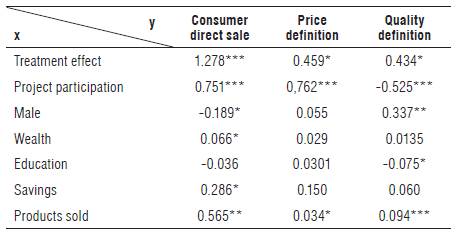
*** P<0.001; ** P<0.005; *P<0.1.
The variable that fully represents project impact is treatment effect; as expected, it has a positive and valuable significance in all aspects analyzed, showing the highest positive influence on direct sale to consumers. That outcome confirmed our expectations and also the results of the interviews, proving the project key role in improving direct sale and its smoother influence on price and quality determination. Socio-economic variables registered ambiguous influence and significance. A uni-vocal conclusion can be drawn only for quantity of good sold that has a remarkable and positive significance in all aspects, confirming that the involvement in this activities is positively correlated with the quantity and types of goods produced. Impact analysis results were complemented by multinomial analysis. This investigation confirmed that the treated group is more likely to be involved in activities to ameliorate trade. Indeed, the percentage of beneficiaries introducing business improvement is higher than non-participants.
Furthermore, the notable role played by variables wealth and farmers' group participation was stressed. Activity engagement is positively linked with wealth level, which means that richer farmers have more possibilities or more interest to increase market abilities. Equally significant is local producers' group participation that boosts project activities involvement.
Interviews showed that commercial improvements not only included economic and business enhancements but also several intangible and non-economic aspects that increased overall farmers' wellbeing. The majority of non-economic dimensions were not analyzed with quantitative approach. However, participants considered these aspects equally important as income increase and market diversification. Thanks to project participation and attendance to workshops, beneficiaries not only developed an entrepreneurial mentality and soft skills which are extremely useful for the management of their businesses, but also private life organization. Additionally, direct relation with costumers was fundamental to increase the participants' self-esteem and confidence, valorize family farming activities and peasants' role, and raise consumers' awareness of smallholders' claims.
Economic performance
Economic efficiency embraces those activities aiming at introducing novelty and innovation to smallholders' businesses, increasing productivity and supply, and positively influencing their profits (Parrado and Molina, 2014). This dimension is composed by the following variables: introduction of organic cultivation practices, introduction of product exchange among project participants, and supply diversification given by sale of uncommon products in the local area.
Interviews clarified that improvements in these dimensions were achieved mainly through participation to the workshops organized within the project framework that mainly dealt with more efficient production techniques and market practices. Through these workshops, participants obtained a set of tools and knowledge to boost productivity and increase yields, as well as a full comprehension of overall market processes that clarified price definition mechanisms, market negotiation, costumer care and sale arrangement practices. An important remark is that workshops effectiveness was strongly determined by project participants' initial features. Beneficiaries were extremely differentiated in relation to management abilities and mechanization. Qualitative analysis showed that the most benefitted participants were those smallholders who lacked strong productive mechanization and had poor organizational abilities. However, all people interviewed agreed that trainings positively affected their businesses.
Participants' diversity highly influenced economic efficiency enhancements. Consequently, improvements in this dimension have not been as straightforward as in the previous topic. As shown in Figure 3, there is not a strong difference between treated and control groups regarding organic practices implementation and commercialization of non-regional products, while there is an outstanding discrepancy in relation to product exchange practices.
Impact analysis confirms descriptive statistics results (Tab. 3). Indeed, the investigation showed strong project significance on the product exchange / barter dimension. However, no statistical correlation was found between project participation and implementation of organic cultivation practices even if outcomes showed positive project influence. Regarding cultivation of non-local products, project participation seems to have a negative impact. Nevertheless, this result was not statistically confirmed. Socio-economic variables have an ambiguous impact and a weak influence, the only exception is represented by quantity of product sold that had a strong and proved significance in all aspects considered.
Impact analysis outcomes were complemented by multinomial analysis. In particular, it clarified the role of socio-economic variables. The analysis confirmed higher beneficiaries' engagement in activities that led to business returns. It is important to highlight the positive influence of farmers' group participation, volume of products sold and wealth level on activity involvement.
The different analyses showed that together with project participation, participant's features had a crucial role in achieving economic improvements. Additionally, several unobservable variables affected outcomes of this dimension, in particular the project leading foundation and associations' role. Given that they were in charge of training organization and management, workshops contents were often influenced by organization sensitiveness and commitment to different topics. A clear example of this is given by the leading role that "Fundación San Isidro" had in sensitizing and educating project participants on agro-ecological practices. In comparison with other beneficiaries, smallholders that attended to trainings organized by this association were more informed and committed to agro-ecological cultivation, preservation of traditional products and food sovereignty.
Political participation
The project aimed at to ameliorate all aspects of smallholders' livelihoods in order to reach sustainable and comprehensive improvements in beneficiaries' well-being. To meet this goal, activities that influenced social and political dimensions were implemented, besides economic and technical ones. In particular "Mercados Campesinos" focused its efforts on decreasing peasants' underrepresentation and low political recognition of the smallholders' needs and claims, increasing participants' advocacy power and influence on political decisions. These goals were achieved mainly thanks to the organizational structure of the project, namely the creation of local producer groups in each village that ensured active beneficiaries' involvement in project activities definition and management. Through direct involvement in the decision making process, participants acquired the abilities needed to express their requests and understood collective action strength and efficiency. Farmers' group constituted the milestone to build confidence and collective organization structure necessary to pressure at local and regional levels.
Political participation improvements were measured with the following variables: local committees' participation, advocacy activities participation, meetings with local politicians, and participation in the creation of a law proposal draft. The analysis undertaken expressed ambiguous results. Descriptive statistics showed a marked difference between beneficiaries and the control group regarding commitment to advocacy activities that becomes particularly significant in relation to the participation level of the farmers group (Fig. 4). This result is particularly relevant because it indicates that smallholders are rarely used to gather into groups and act collectively.
The impact analysis recorded a positive influence of the project without stating a significant correlation between project participation and the improvements reached. No relevant influence of the variables on participants' political engagement was recorded, except for the local producers' group membership. However, it is worthy to highlight that if the participation of the producers' group is considered an independent variable and not an indicator, it has a fundamental role in boosting participation to project advocacy activities. The combined effect of these results with the key role of the treatment variable on the farmers group participation indicator, would suggest that project participation indirectly influences all the other activities. Indeed, if the independent variable participation to producer group is eliminated, treatment effect acquires a positive and significant role. It is also worth mentioning the strong correlation between governmental program awareness and engagement in political activities.
TABLE 4 Impact analysis result of political improvements.

Source: own elaboration.
*** P<0.001; ** P<0.005; * P<0.1.
Impact analysis results have been cleared up by the multinomial investigation that confirmed a high positive influence of governmental programs awareness on peasant active citizenship. Additionally, it highlights the significant role of project participation on beneficiaries' political engagement. Outcomes of descriptive statistics and multinomial analysis are totally in line with the interviews results, which confirmed that "Mercados Campesinos" increased knowledge of agricultural political issues, peasant confidence in exerting pressure at the local level and in promoting sensitizing activities with market costumers.
Outcomes of the interviews clarified that the participation of local producers' groups had a positive influence on several dimensions besides improving active citizenship and political awareness. Initially, smallholders developed a sense of belonging and attachment to traditions and community and, and simultaneously, they gained managerial and organizational competencies and full comprehension of the market structure.
Conclusions
The impact analysis of the results in "Mercados Campesinos" project shows that this initiative offered tools and activities to improve peasants' livelihood through a process that changed smallholders' perceptions about themselves and their occupation.
The quantitative and qualitative methodologies of this study indicated that the process had some contradictory results in terms of economic and commercial improvements. The results ensure that farmer markets in Bogota have been extremely successful and have led to an increase in beneficiaries' income and productivity. However, not all beneficiaries obtained an equal profit from the participation in the project. Socio-economic variables such as family incomes, agricultural tools endowment and organizational abilities played an important role in defining the degree of satisfaction and engagement in project activities. Additionally, the results achieved in Bogota farmer markets, such as the ability to overcome market intermediaries and to define good prices, were not easily replicable out of the "Mercados Campesinos" structure.
Smallholders' organizations played an important role not only in project organization, but also in creating a cultural and political base for cooperation among smallholders that strengthened producers and the entire rural community. This condition has been fundamental to create smallholders' awareness of their crucial role in the food supply chain and, consequently, start consumers' sensitization.
Lastly, it is important to stress that the project pointed out how productive and institutional dimensions are strongly interlinked. Indeed, peasant foundations and associations and local farmers committees not only influenced notoriously the political participation but also increased the economic efficiency. Regarding the social and political role of agriculture as a source of local development, the project strengthened rural economies and valorized indigenous and local products. Mercados Campesinos provided few actions that could be implemented to employ the political role of agriculture to reach territorial development. How to delineate and design this last element should be studied and investigated in further researches. In particular, strategies that could foster smallholders' associations advocacy and collective activities independently from projects implementation should be identified. Rural extension programs should focus their efforts on promoting short food supply chain based on a bottom up approach that starts with the direct involvement of farmers' associations and smallholders in order to ensure public policy efficiency.




![Post-harvest quality of pineapple guava [Acca sellowiana (O. Berg) Burret] fruits produced in two locations at different altitudes in Cundinamarca, Colombia](/img/pt/prev.gif)








